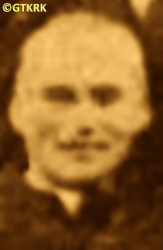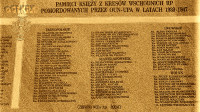Roman Catholic
St Sigismund parish
05-507 Słomczyn
85 Wiślana Str.
Konstancin deanery
Warsaw archdiocese, Poland
full list:
displayClick to display full list

searchClick to search full list by categories
wyświetlKliknij by wyświetlić pełną listę po polsku

szukajKliknij by przeszukać listę wg kategorii po polsku

Martyrology of the clergy — Poland
XX century (1914 – 1989)
personal data
surname
MOŁDOCH
surname
versions/aliases
MOŁODOCH, MAŁDOCH
forename(s)
Andrew (pl. Andrzej)
forename(s)
versions/aliases
Adam
function
diocesan priest
creed
Latin (Roman Catholic) Church RCmore on
en.wikipedia.org
[access: 2014.09.21]
diocese / province
Lviv archdiocesemore on
en.wikipedia.org
[access: 2013.05.19]
Mogilev archdiocesemore on
en.wikipedia.org
[access: 2013.06.23]
Tiraspol diocesemore on
en.wikipedia.org
[access: 2014.11.14]
honorary titles
„Medal of Independence”more on
„Medal of Independence”
(07.07.1931)
date and place
of death
11.1940

alt. dates and places
of death
09.1939, 11.1940 (after)
Lvivtoday: Lviv urban hrom., Lviv rai., Lviv obl., Ukraine
more on
en.wikipedia.org
[access: 2022.01.16]
details of death
After outbreak of the World War I as a seminarian of the Theological Seminary in Lviv sent by Austrian authorities to one of the hospitals at the border with Russia.
After Austrian defeats in 1914 taken with a group of seminarians a POW by the Russians.
Deported to Tomsk, deep inside Russia.
In 1916 moved to Saratov on Volga river.
In 1918, after ordination in Saratov (Tiraspol diocese), went to Sankt Petersburg and was sent to his first parish.
After Polish–Russian war of 1919‐22 and Riga accord left Russia and in 1921 returned back to Poland and his Lviv archdiocese.
After German and Russian invasion of Poland in 09.1939 and start of the World War II, after start of Russian occupation, unable to continue his prefect duties in Lviv — Russians changed Polish secondary schools into Soviet type schools — without religious education — moved to Rava‐Ruska prob. helped Polish clandestine resistance Armed Struggle Union ZWZ army (later part of the Polish Clandestine State) emerging under Russian occupation.
Arrested by Russian NKVD on 22.11.1940 during the return trip by a train from Lviv to Rava‐Ruska, on the train or at final station.
Fate thereafter unknown.
alt. details of death
Few days after German and Russian invasion of Poland in 09.1939, start of the World War II and start of Russian occupation murdered together with another priest Fr John Schiller and Polish State Police unit in Domaszyn, Joseph Gołąb, by local Ukrainians.
Quoted then as Fr Adam Małdoch.
cause of death
extermination
perpetrators
Russians
sites and events
Ribbentrop‐MolotovClick to display the description, Pius XI's encyclicalsClick to display the description, Polish‐Russian war of 1919‐1921Click to display the description
date and place
of birth
1890

presbyter (holy orders)
ordination
21.12.1917

Saratovtoday: Saratov oblast, Russia
more on
en.wikipedia.org
[access: 2022.02.04]
St Clement, the Pope and Martyr RC cathedral churchmore on
en.wikipedia.org
[access: 2025.03.14]
positions held
1939 – 1940
vicar — Rava‐Ruskatoday: Rava‐Ruska urban hrom., Lviv rai., Lviv obl., Ukraine
more on
en.wikipedia.org
[access: 2022.01.16] ⋄ St Joseph Spouse of the Blessed Virgin Mary RC parish ⋄ Zhovkvatoday: Zhovkva urban hrom., Lviv rai., Lviv obl., Ukraine
more on
en.wikipedia.org
[access: 2020.11.22] RC deanery
1925 – 1939
prefect — Lvivtoday: Lviv urban hrom., Lviv rai., Lviv obl., Ukraine
more on
en.wikipedia.org
[access: 2022.01.16] ⋄ secondary schools — i.a. Nicolaus Copernicus' 1st State Lyceum and Gymnasium /till 1937 Gymnasium/ (c. 1928‐1939), Henry Sienkiewicz's 5th State Lyceum and Gymnasium /till 1937 Gymnasium/ (c. 1932‐1939), Private Lyceum and Gymnasium for Girls of the Nazareth Sisters (1938‐1939), Private Gymnasium for Adults at Wałowa Str. (1936‐1937), Casimir the Great 8th State Gymnasium (c. 1931), dr John Niemiec's private school for girls (c. 1928‐1929), Sophie Strzałkowska's Science Institute ofr Girls (frrom 1925)
1925 – 1935
notary — Lvivtoday: Lviv urban hrom., Lviv rai., Lviv obl., Ukraine
more on
en.wikipedia.org
[access: 2022.01.16] ⋄ Archbishop's Metropolitan Court
1925 – c. 1932
vicar — Lvivtoday: Lviv urban hrom., Lviv rai., Lviv obl., Ukraine
more on
en.wikipedia.org
[access: 2022.01.16] ⋄ Assumption of the Blessed Virgin Mary RC archcathedral parish ⋄ Lviv intra Urbemdeanery name
today: Lviv obl., Ukraine RC deanery
1921 – 1925
vicar — Brodytoday: Brody urban hrom., Zolochiv rai., Lviv obl., Ukraine
more on
en.wikipedia.org
[access: 2020.11.20] ⋄ Exaltation of the Holy Cross RC parish ⋄ Brodytoday: Brody urban hrom., Zolochiv rai., Lviv obl., Ukraine
more on
en.wikipedia.org
[access: 2020.11.20] RC deanery
from 1918
vicar — Omsktoday: Omsk oblast, Russia
more on
en.wikipedia.org
[access: 2022.08.05] ⋄ Immaculate Conception of the Blessed Virgin Mary RC parish ⋄ Omsktoday: Omsk oblast, Russia
more on
en.wikipedia.org
[access: 2022.08.05] RC deanery
1918
vicar — Vyatkatoday: Kirov, Kirov city reg., Kirov oblast, Russia
more on
en.wikipedia.org
[access: 2022.02.06] ⋄ Sacred Heart of Jesus RC parish
c. 1911 – 1914
student — Lvivtoday: Lviv urban hrom., Lviv rai., Lviv obl., Ukraine
more on
en.wikipedia.org
[access: 2022.01.16] ⋄ philosophy and theology, Metropolitan Theological Seminary
comments
In this Book it is assumed is identical with Fr Adam Małdoch quoted in some sources.
others related
in death
CHARCZUKClick to display biography Basil, STOKŁOSAClick to display biography Joseph
sites and events
descriptions
Ribbentrop‐Molotov: Genocidal Russian‐German alliance pact between Russian leader Joseph Stalin and German leader Adolf Hitler signed on 23.08.1939 in Moscow by respective foreign ministers, Mr. Vyacheslav Molotov for Russia and Joachim von Ribbentrop for Germany. The pact sanctioned and was the direct cause of joint Russian and German invasion of Poland and the outbreak of the World War II in 09.1939. In a political sense, the pact was an attempt to restore the status quo ante before 1914, with one exception, namely the „commercial” exchange of the so‐called „Kingdom of Poland”, which in 1914 was part of the Russian Empire, fore Eastern Galicia (today's western Ukraine), in 1914 belonging to the Austro‐Hungarian Empire. Galicia, including Lviv, was to be taken over by the Russians, the „Kingdom of Poland” — under the name of the General Governorate — Germany. The resultant „war was one of the greatest calamities and dramas of humanity in history, for two atheistic and anti‐Christian ideologies — national and international socialism — rejected God and His fifth Decalogue commandment: Thou shall not kill!” (Abp Stanislav Gądecki, 01.09.2019). The decisions taken — backed up by the betrayal of the formal allies of Poland, France and Germany, which on 12.09.1939, at a joint conference in Abbeville, decided not to provide aid to attacked Poland and not to take military action against Germany (a clear breach of treaty obligations with Poland) — were on 28.09.1939 slightly altered and made more precise when a treaty on „German‐Russian boundaries and friendship” was agreed by the same murderous signatories. One of its findings was establishment of spheres of influence in Central and Eastern Europe and in consequence IV partition of Poland. In one of its secret annexes agreed, that: „the Signatories will not tolerate on its respective territories any Polish propaganda that affects the territory of the other Side. On their respective territories they will suppress all such propaganda and inform each other of the measures taken to accomplish it”. The agreements resulted in a series of meeting between two genocidal organization representing both sides — German Gestapo and Russian NKVD when coordination of efforts to exterminate Polish intelligentsia and Polish leading classes (in Germany called «Intelligenzaktion», in Russia took the form of Katyń massacres) where discussed. Resulted in deaths of hundreds of thousands of Polish intelligentsia, including thousands of priests presented here, and tens of millions of ordinary people,. The results of this Russian‐German pact lasted till 1989 and are still in evidence even today. (more on: en.wikipedia.orgClick to attempt to display webpage
[access: 2015.09.30])
Pius XI's encyclicals: Facing the creation of two totalitarian systems in Europe, which seemed to compete with each other, though there were more similarities than contradictions between them, Pope Pius XI issued in 03.1937 (within 5 days) two encyclicals. In the „Mit brennender Sorge” (Eng. „With Burning Concern”) published on 14.03.1938, condemned the national socialism prevailing in Germany. The Pope wrote: „Whoever, following the old Germanic‐pre‐Christian beliefs, puts various impersonal fate in the place of a personal God, denies the wisdom of God and Providence […], whoever exalts earthly values: race or nation, or state, or state system, representatives of state power or other fundamental values of human society, […] and makes them the highest standard of all values, including religious ones, and idolizes them, this one […] is far from true faith in God and from a worldview corresponding to such faith”. On 19.03.1937, published „Divini Redemptoris” (Eng. „Divine Redeemer”), in which criticized Russian communism, dialectical materialism and the class struggle theory. The Pope wrote: „Communism deprives man of freedom, and therefore the spiritual basis of all life norms. It deprives the human person of all his dignity and any moral support with which he could resist the onslaught of blind passions […] This is the new gospel that Bolshevik and godless communism preaches as a message of salvation and redemption of humanity”… Pius XI demanded that the established human law be subjected to the natural law of God , recommended the implementation of the ideal of a Christian state and society, and called on Catholics to resist. Two years later, National Socialist Germany and Communist Russia came together and started World War II. (more on: www.vatican.vaClick to attempt to display webpage
[access: 2023.05.28], www.vatican.vaClick to attempt to display webpage
[access: 2023.05.28])
Polish‐Russian war of 1919‐1921: War for independence of Poland and its borders. Poland regained independence in 1918 but had to fight for its borders with former imperial powers, in particular Russia. Russia planned to incite Bolshevik‐like revolutions in the Western Europe and thus invaded Poland. Russian invaders were defeated in 08.1920 in a battle called Warsaw battle („Vistula river miracle”, one of the 10 most important battles in history, according to some historians). Thanks to this victory Poland recaptured part of the lands lost during partitions of Poland in XVIII century, and Europe was saved from the genocidal Communism. (more on: en.wikipedia.orgClick to attempt to display webpage
[access: 2014.12.20])
sources
personal:
cracovia-leopolis.plClick to attempt to display webpage
[access: 2013.01.06], www.kresy.plClick to attempt to display webpage
[access: 2013.01.06], biographies.library.nd.eduClick to attempt to display webpage
[access: 2014.05.09]
bibliographical:
„Register of Latin rite Lviv metropolis clergy’s losses in 1939‐45”, Józef Krętosz, Maria Pawłowiczowa, editors, Opole, 2005
„Biographical lexicon of Lviv Roman Catholic Metropoly clergy victims of the II World War 1939‐1945”, Mary Pawłowiczowa (ed.), Fr Joseph Krętosz (ed.), Holy Cross Publishing, Opole, 2007
„Schematismus Universi Saecularis et Regularis Cleri Archi Diaeceseos Metropol. Leopol. Rit. Lat.”, Lviv Metropolitan Curia, from 1860 till 1938
original images:
dlibra.kul.plClick to attempt to display webpage
[access: 2019.10.13], wegliniec.plClick to attempt to display webpage
[access: 2014.10.31]
LETTER to CUSTODIAN/ADMINISTRATOR
If you have an Email client on your communicator/computer — such as Mozilla Thunderbird, Windows Mail or Microsoft Outlook, described at WikipediaPatrz:
en.wikipedia.org, among others — try the link below, please:
LETTER to CUSTODIAN/ADMINISTRATORClick and try to call your own Email client
If however you do not run such a client or the above link is not active please send an email to the Custodian/Administrator using your account — in your customary email/correspondence engine — at the following address:

giving the following as the subject:
MARTYROLOGY: MOŁDOCH Andrew
To return to the biography press below:
 Click to return to biography
Click to return to biography









